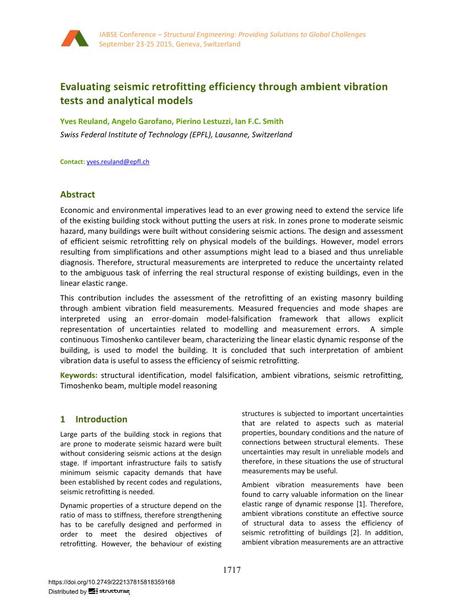Evaluating seismic retrofitting efficiency through ambient vibration tests and analytical models

|
|
|||||||||||
Bibliografische Angaben
| Autor(en): |
Yves Reuland
(Swiss Federal Institute of Technology (EPFL), Lausanne, Switzerland)
Angelo Garofano (Swiss Federal Institute of Technology (EPFL), Lausanne, Switzerland) Pierino Lestuzzi (Swiss Federal Institute of Technology (EPFL), Lausanne, Switzerland) Ian F. C. Smith (Swiss Federal Institute of Technology (EPFL), Lausanne, Switzerland) |
||||
|---|---|---|---|---|---|
| Medium: | Tagungsbeitrag | ||||
| Sprache(n): | Englisch | ||||
| Tagung: | IABSE Conference: Structural Engineering: Providing Solutions to Global Challenges, Geneva, Switzerland, September 2015 | ||||
| Veröffentlicht in: | IABSE Conference Geneva 2015 | ||||
|
|||||
| Seite(n): | 1717-1724 | ||||
| Anzahl der Seiten (im PDF): | 8 | ||||
| Jahr: | 2015 | ||||
| DOI: | 10.2749/222137815818359168 | ||||
| Abstrakt: |
Economic and environmental imperatives lead to an ever growing need to extend the service life of the existing building stock without putting the users at risk. In zones prone to moderate seismic hazard, many buildings were built without considering seismic actions. The design and assessment of efficient seismic retrofitting rely on physical models of the buildings. However, model errors resulting from simplifications and other assumptions might lead to a biased and thus unreliable diagnosis. Therefore, structural measurements are interpreted to reduce the uncertainty related to the ambiguous task of inferring the real structural response of existing buildings, even in the linear elastic range. This contribution includes the assessment of the retrofitting of an existing masonry building through ambient vibration field measurements. Measured frequencies and mode shapes are interpreted using an error-domain model-falsification framework that allows explicit representation of uncertainties related to modelling and measurement errors. A simple continuous Timoshenko cantilever beam, characterizing the linear elastic dynamic response of the building, is used to model the building. It is concluded that such interpretation of ambient vibration data is useful to assess the efficiency of seismic retrofitting. |
||||
| Stichwörter: |
Timoshenko-Balken
|
||||
